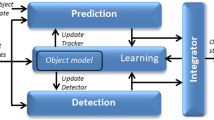Abstract
Occurrence of occlusion while providing visual surveillance leads to anarchy as the track of the subject under motion may be lost. This often results into the failure of the surveillance system. The approach of predicting motion of moving subjects and hence the chances of their mutual occlusion gives an upper hand to surveillance system to take in-time necessary action towards mitigation of loss of track during dynamic occlusion. Direction of motion of a moving subject plays a major role while studying its motion. Direction along with the velocity of a subject in a 3D plane completely describes the motion of any subject. This article proposes a model‘-based approach for direction prediction of a moving subject in a 3D global plane as acquired in a 2D camera plane. The proposed approach uses the eight discrete directions of motion as proposed in and models different directions. The proposed direction prediction method is experimentally verified with six different classifiers, i.e. regression analysis, simple logistic regression, MLP, k-NN, SVM and Bays classifier over existing as well as self-acquired databases. The initial simulation results are motivating as the overall accuracies achieved through different classifiers are of the range of 87–94 \(\%\), which advocates the suitability of the said approach.





Similar content being viewed by others
References
Atev S, Arumugam H, Masoud O, Janardan R, Papanikolopoulos NP (2005) A vision-based approach to collision prediction at traffic intersections. IEEE Trans Intell Transp Syst 6:416–423
Cristani M, Ragavendra R, Bue AD, Murino V (2011) Human behavior analysis in video surveillance: a Social signal processing perspective. Neurocomputing 100:86–97
Raman R, Sa PK, Bakshi S, Majhi B (2012) Towards optimized placement of cameras for gait pattern recognition. In: Proceedings of second international conference of Communication, computing and cameras, pp 1019–1025
Raman R, Sa PK, Majhi B (2012) Occlusion prediction algorithms for multi-camera network. In: Proceedings of IEEE/ACM international conference on distributed smart cameras, pp 1–6
Senior A, Hampapur A, Tian Y, Brown L, Pankanti S, Bolle R (2006) Appearance models for occlusion handling. Image Vision Comput 24:1233–1243
Nguyen HT, Smeulders AWM (2004) Fast occluded object tracking by a robust appearance filter. IEEE Trans Pattern Anal Mach Intell 26:1099–1104
Zhou S, Kevin S, Chellappa R, Moghaddam B (2004) Visual tracking and recognition using appearance-adaptive models in particle filters. IEEE Trans Image Process 13:1491–1506
Jepson AD, Fleet DJ, Maraghi TF (2003) Robust Online appearance models for visual tracking. IEEE Trans Pattern Anal Mach Intell 25:1296–1311
Hariharakrishnan K, Schonfeld D (2006) Fast object tracking using adaptive block matching. IEEE Trans Multimed 7:853–859
Amezquita N, Alquezar R, Serratosa F (2008) Dealing with occlusion in a probabilistic object tracking method. In: Proceedings of IEEE computer society conference on computer vision and pattern recognition, pp 1–8
Barnich O, Droogenbroeck MV (2011) ViBe: a universal background subtraction algorithm for video sequences. IEEE Trans Image Process 20:1709–1724
Horn BKP, Schunck BG (1981) Determining optical flow. Artif Intell 17:185–203
Lucas BD, Kanade T, Schunck BG (1981) An iterative image registration technique with an application to stereo vision. In: Proceedings of the DARPA image understanding workshop, pp 121–130
CASIA Database. http://www.csbr.ia.ac.cn/english/Gait%20databases.asp. Accessed 14 July 2015
NITR Conscious Walk Database. http://www.nitrkl.ac.in/Academic/Academic_Centers/Data_Computer_Vision.aspx. Accessed 2 Aug 2015
Acknowledgments
The authors would like to thank all the co-researchers of Computer Vision Research Labs at The Department of Computer Science and Engineering, National Institute of Technology, Rourkela, for their active co operation towards manifestation of this research.
Author information
Authors and Affiliations
Corresponding author
Rights and permissions
About this article
Cite this article
Raman, R., Sa, P.K. & Majhi, B. Direction prediction for avoiding occlusion in visual surveillance. Innovations Syst Softw Eng 12, 201–214 (2016). https://doi.org/10.1007/s11334-016-0278-6
Received:
Accepted:
Published:
Issue Date:
DOI: https://doi.org/10.1007/s11334-016-0278-6




